

What the pandemic taught us: mental health is a necessary condition for learning — University Affairs. Developing an Industry Job Simulation Program for Graduate and Postdoctoral Trainees in Life Sciences. Archer-Kuhn, B., & Rancourt, D. (2019).
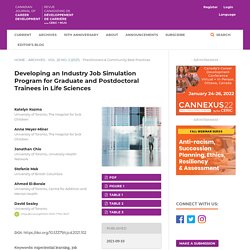
How universities can really help PhD grads get jobs | University Affairs. BioTalentCanada. (2020). The Talent Differential The case for work-integrated learning in the bio-economy. Brandt, P. Chronicle. This month marks the start of the third academic year shaped by Covid-19.

A combination of factors — the more transmissible Delta variant, the lagging vaccination rates, and the mixed support for masks and mitigation strategies — suggest that the fall of 2021 may look more like the fall of 2020 than many of us want to admit. Yet there are steps you can take, as you shape your syllabi, to better support students through what looks to be another thorny semester.
As faculty members, we’ve seen firsthand how students have struggled during the pandemic. Now, in addition to anecdotal evidence, several emerging studies show that the students who have been hit hardest are the same ones that higher education often underserved before the pandemic: students of color and of lower socioeconomic status and those with mental-health concerns and physical and learning disabilities.
How to get students to read your syllabus. Machine Learning Career Path: 5 Potential Jobs - Lighthouse Labs. As Artificial Intelligence becomes increasingly prevalent in our day to day lives, so do jobs related to AI.
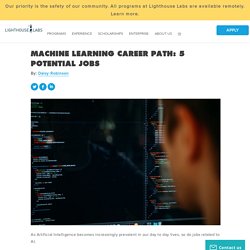
But what exactly are these jobs and how can one break into this field? The answer is machine learning. Aka, how machines can learn and understand human tasks. In fact, according to Simplilearn, “machine learning jobs are projected to be worth almost $31 billion by 2024” all thanks to growing almost 75% over the last four years. What Is Machine Learning? Machine learning is a branch of Artificial Intelligence that focuses on data and algorithms to enable machines to learn a task with minimal human intervention.
Conestoga news, events and announcements. Inspired by the Conestoga Gig Lab, Canada's first and only business incubator for freelance entrepreneurs, a new micro-credential starting this September will help individuals start and optimize their freelance business.
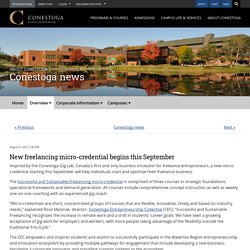
The Successful and Sustainable Freelancing micro-credential is comprised of three courses in strategic foundations, operational frameworks and demand generation. All courses include comprehensive concept instruction as well as weekly one-on-one coaching with an experienced gig coach. “Micro-credentials are short, concentrated groups of courses that are flexible, innovative, timely and based on industry needs,” explained Rose Mastnak, director, Conestoga Entrepreneurship Collective (CEC). “Successful and Sustainable Freelancing recognizes the increase in remote work and a shift in students' career goals. We have seen a growing acceptance of gig work for employers and workers, with more people taking advantage of the flexibility outside the traditional 9-to-5 job.”
Resources to better understand the micro-credentials landscape in Canada - CareerWise. The Progress Principle and the Power of Small Wins. What is the best way to motivate employees to do creative work?

Help them take a step forward every day. The Progress Principle describes the findings of a multi-year research project that Teresa Amabile and Steven Kramer conducted to discover what makes people happy, motivated, creative and productive at work. They asked 238 people working on creative teams to send a confidential electronic “diary” at the end of each work day for the entire length of a project. The diary form asked participants to provide ratings on their inner work life — the constant stream of emotions, perceptions and motivations that people experience as they go through their work days. They were also asked to describe one event that stood out in their mind from the day – any event that was relevant to their work. Having a positive inner work life is key to making progress. ‘Test and learn’: A powerful approach to measure the impact of soft skills development. Determining the impact of learning programs continues to be a real challenge for many organizations.
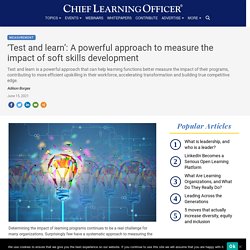
Surprisingly few have a systematic approach to measuring the impact of their L&D initiatives, particularly when it comes to actions designed to improve capabilities or interpersonal skills, such as leadership or soft skills. However, understanding the impact of these initiatives on participants, beyond the immediate perceived satisfaction, is a key factor in justifying the investments made. Moreover, objectively assessing the impact of these programs allows you more influence and resources to put toward development programs, which, in turn, increases the learning team’s impact on organizational transformation. Yet, measuring this impact is not easy. A number of factors can influence the results of a learning program, and this is particularly true for those focused on soft skills.
Presentation handouts and leave-behinds. How to add slide numbers in PowerPoint. Adding slide numbers in PowerPoint, on the face of it, is pretty easy.
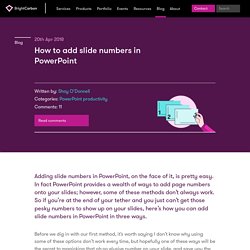
In fact PowerPoint provides a wealth of ways to add page numbers onto your slides; however, some of these methods don’t always work. So if you’re at the end of your tether and you just can’t get those pesky numbers to show up on your slides, here’s how you can add slide numbers in PowerPoint in three ways. Bye-bye four-year degree. Canadian companies want workers faster. Article content Last summer, Marcos Chumacero, an out-of-work bar manager, lolled about his downtown Toronto apartment as the world slowed to a crawl and the federal government went on COVID-19 damage control.

“Like everyone else in my industry, I was collecting CERB,” he recalled, referring to the $2,000-per-month emergency benefit. A chance call to an acquaintance in social work changed his life. The friend told Chumacero, 30, about NPower, a charity that retrains younger workers who lack computer skills for jobs in the information-technology (IT) industry.
He applied and was accepted into a three-month program in September that taught computer protocols and networking among other related subject matter. No more CERB. By January, Chumacero had landed a job at Touchbistro Inc., a payments software firm for restaurants, as a bilingual product technician. Advertisement This advertisement has not loaded yet, but your article continues below. Share this article in your social network. This fall, many instructors are teaching the pandemic. Several universities have introduced new courses or adapted existing ones to instruct students on the complex dynamics of COVID-19.
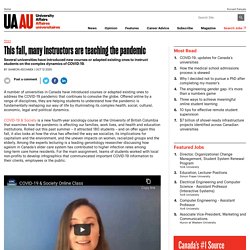
A number of universities in Canada have introduced courses or adapted existing ones to address the COVID-19 pandemic that continues to convulse the globe. Offered online by a range of disciplines, they are helping students to understand how the pandemic is fundamentally reshaping our way of life by illuminating its complex health, social, cultural, economic, legal and political dynamics. COVID-19 & Society is a new fourth-year sociology course at the University of British Columbia that examines how the pandemic is affecting our families, work lives, and health and education institutions.
Keeping global learning alive in an age of remote course delivery. Initiatives like Globally Networked Learning are a response to the challenges posed by COVID-19 to international mobility.
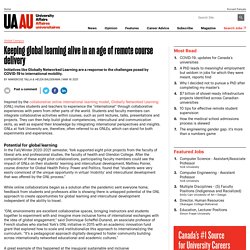
Inspired by the collaborative online international learning model, Globally Networked Learning (GNL) invites students and teachers to experience the “international” through collaborative experiences with peers from other parts of the world. Students and faculty members can integrate collaborative activities within courses, such as joint lectures, talks, presentations and projects. They can then help build global competencies, intercultural and communication skills, as well as expand their knowledge by integrating international perspectives and insights. GNLs at York University are, therefore, often referred to as GNLEs, which can stand for both experiments and experiences. Potential for global learning. Online Learning Should Return to a Supporting Role. As the coronavirus pandemic forces schools and college campuses to go online, the delivery model of education — largely unchanged for centuries — has suddenly been disrupted. This may seem like the acceleration of a permanent shift toward online learning, but I have my doubts.
In fact, economics tells us that technology will make in-person education more valuable than ever. At the moment, teachers from kindergarten through graduate school are struggling to take their classes online, and the initial results are, understandably, spotty. But the longer this mass experiment continues, the more familiar remote learning will become. We need an outcomes-based approach to doctoral education. It’s crucial that we restructure our PhD programs from beginning to end to reflect the actual – as opposed to imagined – career outcomes of our students. Recently, Statistics Canada published its “Labour market outcomes of postsecondary graduates, class of 2015.”
No one should be surprised that the report does nothing to lessen the urgency of the need to reform doctoral education in the 21st century. In fact, several statistics are downright concerning for an educational enterprise that successfully places but one-fifth of its graduates on the career path for which it was designed. Learning management systems are more important than ever. Somehow, last spring, teaching and learning staff at the University of Saskatchewan found the time to make a big decision: the university would migrate its learning management system, or LMS, from Blackboard Learn to Canvas.
Back in the fall of 2019, the university had narrowed its search to two competing systems. Consultations and tests wrapped up before the university went into lockdown due to the pandemic, and in May 2020 it had signed with Instructure, the Salt Lake City company that offers Canvas. Glossary Redefining Workplace Learning Analytics. HBR Guide to Building Your Business Case Ebook + Tools. Active Learning Activities - SALTISE. Helpful Resources - SALTISE. Designing Microlearning. Adjusted Syllabus - Google Docs. Microlearning Resources. Icebreakers: Be Strategic. The best free PowerPoint templates online. When creating presentations in PowerPoint it’s important to have a template to ensure design consistency, but it takes time, effort and skill to create high quality templates and masters.
Of course, there are lots of places you can get free PowerPoint templates, but are they any good? Well, we’ve done the legwork for you and have collected a few of the best free PowerPoint templates online. Before we get started, a word of warning: Even nice-looking templates can be ineffective if the layouts are just bullet points on bullet points. Whichever PowerPoint template you chose, you should still try to create visual, engaging slides. Treating these free PowerPoint templates as building blocks, rather than finished masterpieces will help you create something more customised to your needs. Slidesgo Slidesgo has lots of templates that can be used either in PowerPoint or Google Slides. The Slidesgo templates are easily editable: you can move elements around and duplicate or delete them.
How to Write a Syllabus. Using Zoom to Engage Students. Building blocks for online learning. How to compress PowerPoint presentations. Media-rich presentations are great. Including high-quality images and videos often adds hugely to audience engagement, but it also adds file size. Support Online Learning with Powerful Thinking Routines – Dr. Catlin Tucker. Project Zero at Harvard’s Graduate School of Education has created a collection of Core Thinking Routines as part of their Visible Thinking Project. Teachers can view the entire collection on the Project Zero website, where each routine is described in detail (e.g., purpose, application, launch) in both English and Spanish. Teaching: How to Give Students a Break From Their Screens — in an Online Course. Moodle. Moodle. 6 Exercises to Get to Know Your Students Better—and Increase Their Engagement.
The Power of Student Check-Ins During Distant Learning and Hybrid Courses - John Spencer. 5 Ways to Prepare for Adobe Flash Expiration. 4 Favorites for Phenomenal Virtual Facilitation. Don't Overlook Accessibility in E-Learning. What is Facilitation? What Are the Differences Between Facilitation, Presentation, and Training? Trainers help others improve their performance by teaching, instructing, or facilitating learning. Any Questions? UDL + Design Thinking = Designing for All Learners. Empathy: Beyond the Jargon - Microsoft Design. 8 Steps to Creating a Virtual Employee Onboarding Program. 100+ Bloom's Taxonomy Verbs For Critical Thinking. An Introduction to Bloom's Taxonomy for Instructional Designers. Start (and end) the term with student questions — Pedagogy Unbound. The 3 Essential Functions of Your Syllabus, Part 1.